Reishunger Digital Rice Cooker
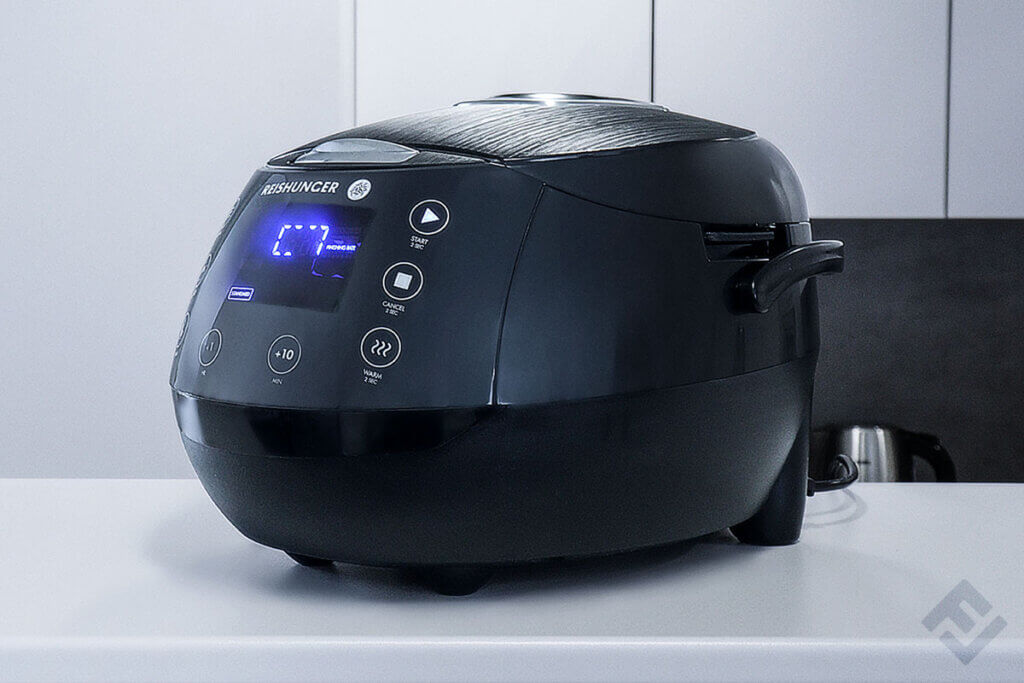
Pros
- Lots of features
- Also works for grains, soups, and cake
- Handle for easy transport
- No need to check on it while cooking
Cons
- No dishwasher-safe components
- Measuring scale starts at two cups
- No power button
Rating
8 / 10
FinalCheck verdict
This digital rice cooker from Reishunger isn’t just great for making perfect white rice – it has loads of other features and modes for different types of rice. You can use it to steam vegetables, cook grains, and even bake cakes. Unfortunately, since there’s no power button you can only fully switch it off when you unplug it from mains power.
First impressions





Design and build quality





Features





Performance





The product presented here was provided to us free of charge by Amazon. The provider had no influence on the test criteria or our rating.
First impressions 




From simple models with one temperature setting and a keep warm mode through to premium devices with adaptive cooking and induction heating, easy, perfect rice any time is the core competency of any rice cooker worth its salt. This digital rice stove from Reishunger is in the mid-range: It uses a standard heating element to cook different types of rice, and has a total of seven heat settings.
The Reishunger rice cooker measures 39 x 39 x 24cm; weighing just over five kilograms. Thanks to the practical carrying handle, it’s easy to move around say from kitchen through to dining table.
The cooker comes with an instruction manual and various accessories which you’ll find packaged inside the cooking chamber. These include a measuring cup with a capacity of 180 milliliters or one cup, a nubbed, flat rice serving spoon, a smooth rice ladle, a holder for the spoons, a perforated steamer insert and a short power cable. The length of the power cable does limit your options for placing it it down, as the cooker needs to be close to mains power – this is an issue common to many modern kitchen appliances.
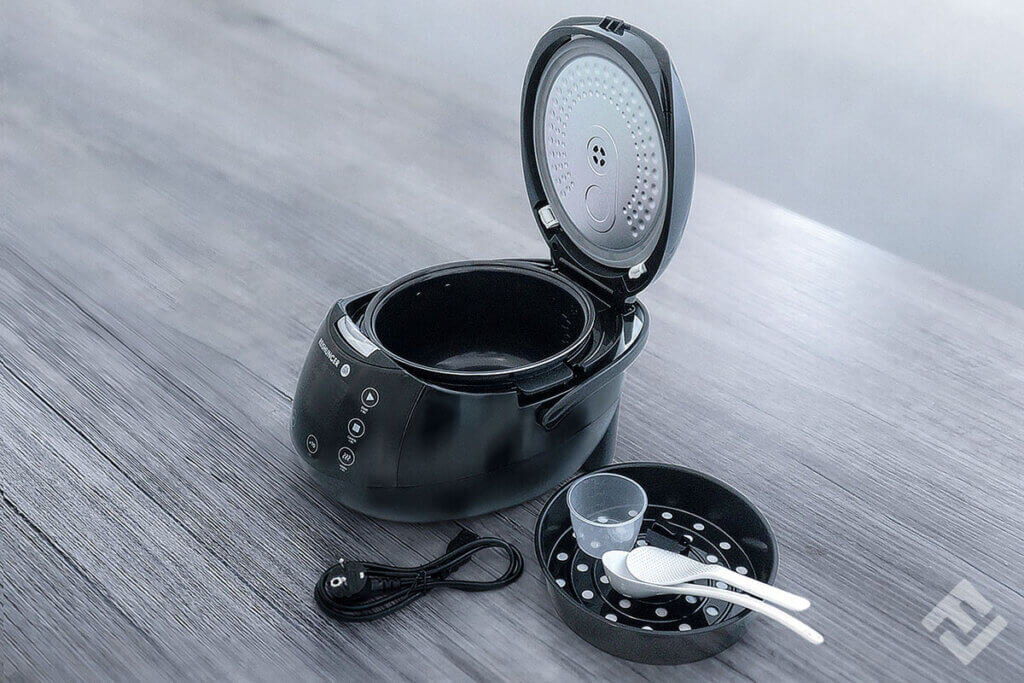
Design and build quality 




We tested the black version of the rice stove. Visually, it’s reminiscent of a motorcycle helmet or a portable CD player. The dark surface looks classy, especially since the material structure of the lid resembles brushed stainless steel, although it is just made from sturdy plastic. The large display on the front gives the device a modern touch.
If you press the button above the display, the lid opens very jerkily, which does destabilise the rice cooker if it isn’t full. Injuries could occur when opening the lid if hot water splashes onto the skin, for example. The inner pot is non-stick – ceramic-based, according to Reishunger – and has a measuring scale. It shows the cups used on the right side and the milliliter number on the left. Somewhat impractically, the scale only starts at two cups. It is therefore only usable for larger quantities of rice. The two handles on the sides of the inner pot are again helpful. These are heat-insulated, so you can remove the pot with freshly cooked rice without burning yourself.
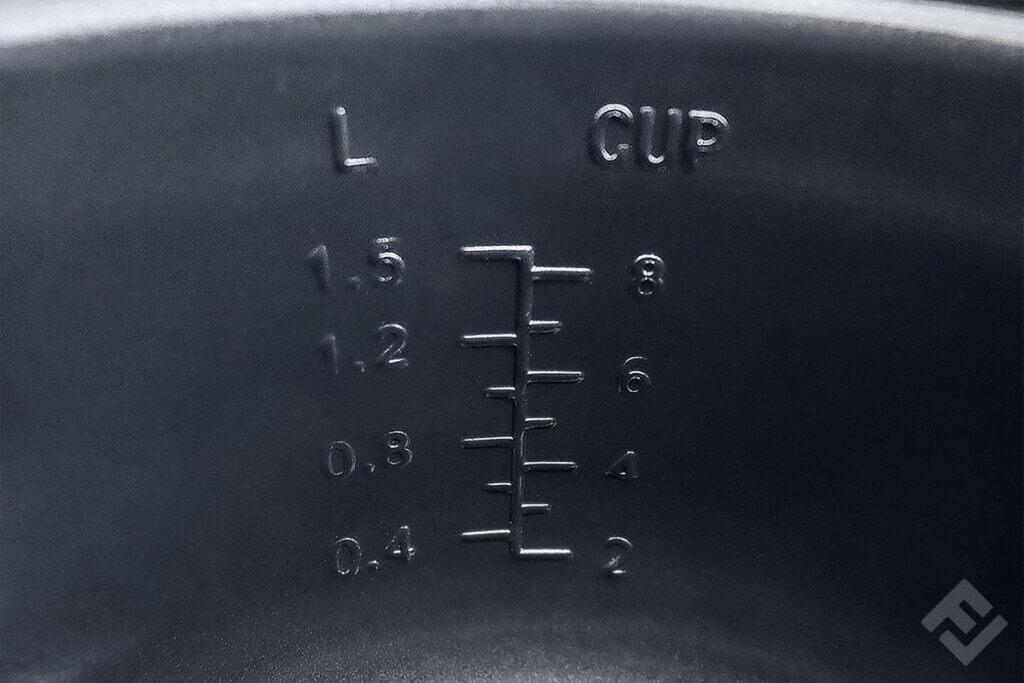
The overall 1.5 liter capacity of the rice cooker means you can make up to eight portions of white rice – for brown rice, Reishunger recommends up to five portions. After cooking, you’ll need to wash the cooking pot out carefully by hand so as not to damage the non-stick coating – it is not dishwasher-safe.
The inside of the lid is made from aluminium and has a seal. There are two buttons which let you take it off for cleaning.
When clicking the inner lid back in, don’t apply pressure between the switches as the lid can come loose from the sealing ring if too much pressure is applied – just press on the two buttons.
The design of the plastic container on the back is well thought out. It is used to collect the condensation that occurs during rice cooking. This can then be emptied after cooking.
Features and ease of use 




The rice cooker has a large digital display with blue LED lighting that shows the individual functions and settings options. These can be selected via eight control buttons around the display. Their respective functions are easy to understand thanks to the pictograms.
The rice cooker has a total of twelve cooking modes, including a standard rice programme, a programme for white, wholemeal and sushi rice, a programme for rice porridge, quinoa and cereals, one for steaming and even a programme for baking cakes.
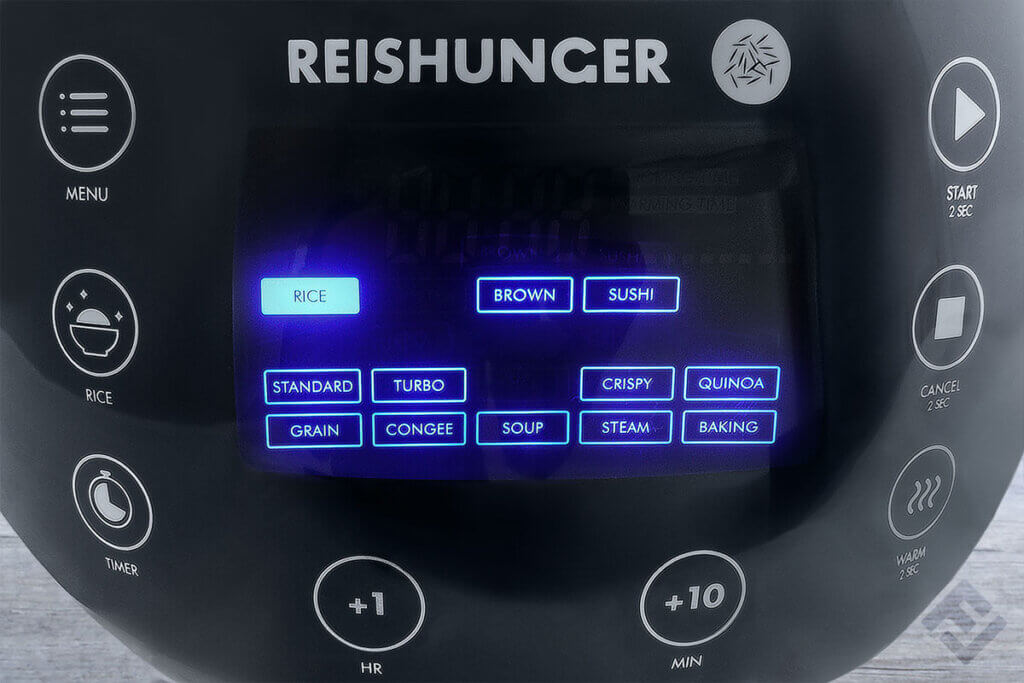
The manual explains in detail everything you need to know about each cooking programme. The tables for water/rice ratio and the preparation table for steaming different foods are particularly useful. It also explains how to pre-set a timer or extend the cooking time, for example.
To select a specific cooking mode, press the menu button until the programme you want flashes on the display. It isn’t possible to select a specific programme directly. The three functions “White”, “Brown”, and “Sushi” can be accessed via the menu item “Rice”. To select one of the three programmes, it is necessary to first navigate to “Rice” with the menu button and then press the “Standard” button, which is placed below it. This is not particularly intuitive, and we wondered why the three functions aren’t arranged on the same level as the other programmes.
Performance 




Of course, in any rice cooker test, the first thing to do is make a batch of rice. However, as recommended in the instruction manual, before cooking a batch, we first let the rice cooker run with just water for 20 minutes in standard mode. To put the cooker through its paces, we decided to cook one cup each of white jasmine rice in standard and turbo mode and two cups of wholemeal long grain rice in brown rice mode.
Preparation
For each run, we washed the rice several times and added it to the rice cooker with the amount of water recommended in the instructions. Then all we had to do was close the lid and select the appropriate mode.
To test standard mode, we just had to press start – as you might expect, the standard mode is the one automatically set on the cooker. To select turbo mode, all we had to do was press the menu button twice. To select the brown rice mode, you need to press the menu button three times and then the rice button twice. The instructions are clear for doing this and the set-up isn’t a problem, but you will want to read the manual first to avoid confusion.
While the rice is cooking, a loading bar slowly fills up; there isn’t an exact time indicator. When finished, the cooker will beep and automatically go into keep-warm mode. This turns on a timer which counts how long the rice has been keeping warm for.
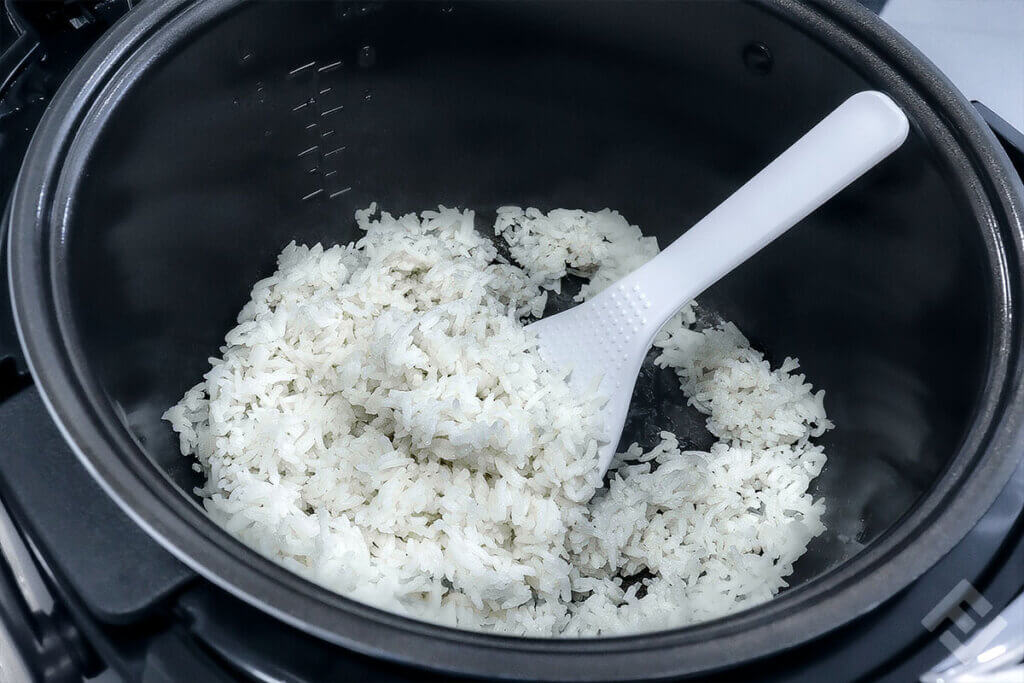
To cook the next batch of rice, we disconnected the rice cooker from the power, washed the pot, and filled it with new rice and water. As soon as the plug was back in the socket, the rice cooker immediately went into keep-warm mode from when it was last plugged in – even though the cooking pot wasn’t even in the cooker. We weren’t aware that the previous mode has to be stopped manually by pressing the cancel button, even if the appliance has been disconnected from power and the cooking pot removed. Considering the lack of an on/off button, this design is somewhat questionable.
An ability to detect if the cooking pot is inserted would be a useful feature. For example, if you remove the pot to transfer rice and don’t put it back in, the rice cooker stays in keep-warm mode despite there being nothing inside it.
Test results
Cooking times were largely in line with what we expected from the estimates in the manual. In standard mode, the rice was ready after around half an hour, while turbo mode took about 25 minutes. The wholemeal rice took about ten minutes less in turbo mode – 50 minutes instead of at least an hour. The results were mixed. While the white rice was very well cooked in standard mode and had an excellent consistency, there was some residual moisture in turbo mode. The white rice in standard mode was restaurant quality.
With the wholemeal rice, on the other hand, we had a few problems. Although we stuck to the recommended water-to-rice ratio, the rice grains were partly broken and unevenly cooked. The consistency was grainy in some places and mushy in others.
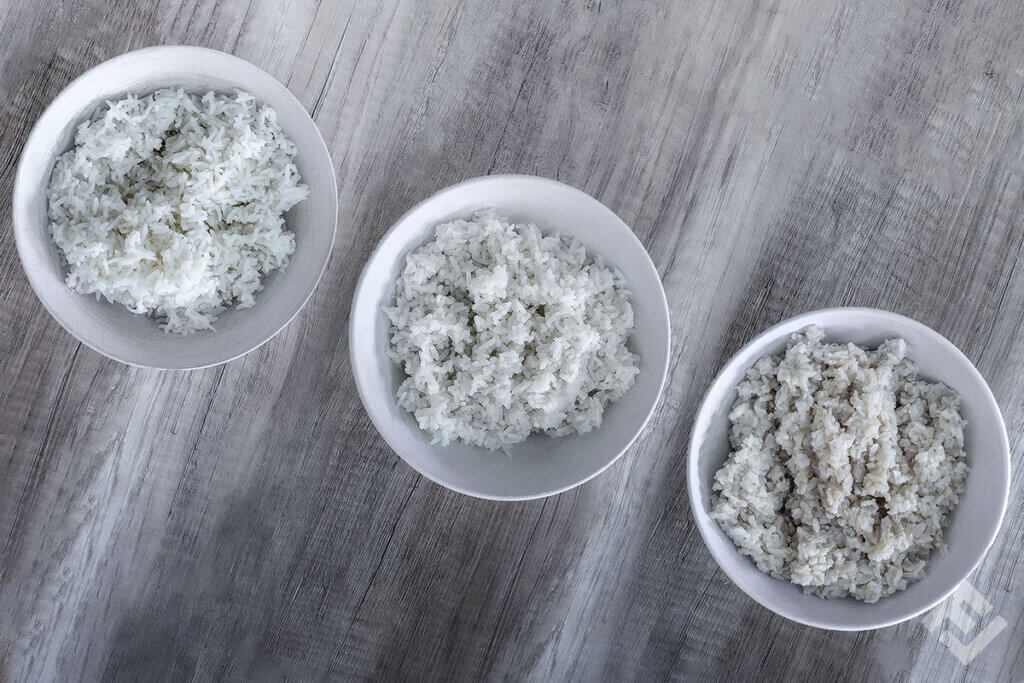
Summary
This Digital Rice Cooker from Reishunger is a well-designed device with loads of functions and simple, easy-to-learn controls. Selecting some of the cooking modes isn’t very intuitive, but, once you get that figured out, the cooker works well. We found the lack of a power button to be an issue, along with the fact that the cooker stays in keep-warm mode when you open the lid and take the pot out, unless you press the cancel button.
The cooker did an excellent job preparing white rice, but our wholegrain rice test wasn’t successful. Whether there are problems with whole-grain rice in general or whether it is just a learning factor requires further testing. The other functions also require test runs to make a definitive statement about their usefulness.
Overall, this is a powerful appliance that can make work easier, especially in multi-person households. However, the rice cooker is not suitable for users who only want white rice quickly – after all, it takes longer to prepare than in a saucepan. For those who value additional modes, such as preparing cereals or cakes, the appliance is a good choice. The rice cooker can also be worthwhile for individuals who take advantage of the wide range of functions, like to cook in advance or often have visitors.
Featured Image: © FinalCheck | Images 1-5: © FinalCheck
